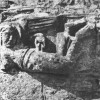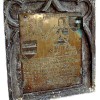To some it is an interesting folly; to others it is a blot on the landscape and to a telecommunications company it is a very convenient perch for their mobile phone aerials. To its builder it was a seat from which he could watch the hunt when he was too old to ride to hounds himself or gaze up at the heavens. We are talking about Horton Tower or, as its builder liked to refer to it, Horton Observatory.
Pevsner describes the builder as a “megalomaniac” and before you accuse the old man of going over the top just remember the same builder was responsible for submerging the village of Moor Crichel just so he could have a lake in his front garden.
The man who wanted a room with a view was Sir Humphrey Sturt. He was born in 1725 and doesn’t seem to have wasted a moment of his six decades; he died on the 20th October 1786. He was the son of Humphrey Sturt of Horton and Diana Napier. On the 27th of April 1756 at St. James, Westminster, he married Mary Pitfield the daughter of Charles Pitfield and Dorothy Ashley; it is through his wife he inherited Moor Crichel. The family wealth came from his grandfather, Sir Anthony Sturt, a businessman, City of London Alderman, and a victualler to the Navy.
Elsewhere he has been described as “energetic, ambitious and wealthy” – and to this we would add visionary. He had many ideas for improving agriculture that were ahead of the times and he introduced them in the Crichels and on Brownsea Island, which he bought in 1765. He used steam power for threshing and records suggest he spent £50,000 improving the castle and gardens on Brownsea and bringing enormous quantities of manure to the island where he planted several new crops. He was an architect and the MP for Dorset between 1745 and his death in 1786.
Sturt’s Tower sits in open country a little outside of Horton village. Its six storeys with brick walls rise 140 feet above the ground and originally there was a fireplace half way up it. Above the fourth storey the straight sides have classical pediments and the round turrets have ogee domes, with ball finials; all openings have two-centred heads. The woodwork has gone but there are beam-holes for six floors which Pevsner thought would allow for up to eighteen rooms.
This folly was used as the location for the cock-fighting scene in John Schlesinger’s film version of Hardy’s Far From the Madding Crowd . Love it or hate it you cannot miss Horton Tower – it can be seen from miles around.
We have posted a photo of the tower in the photo section.



